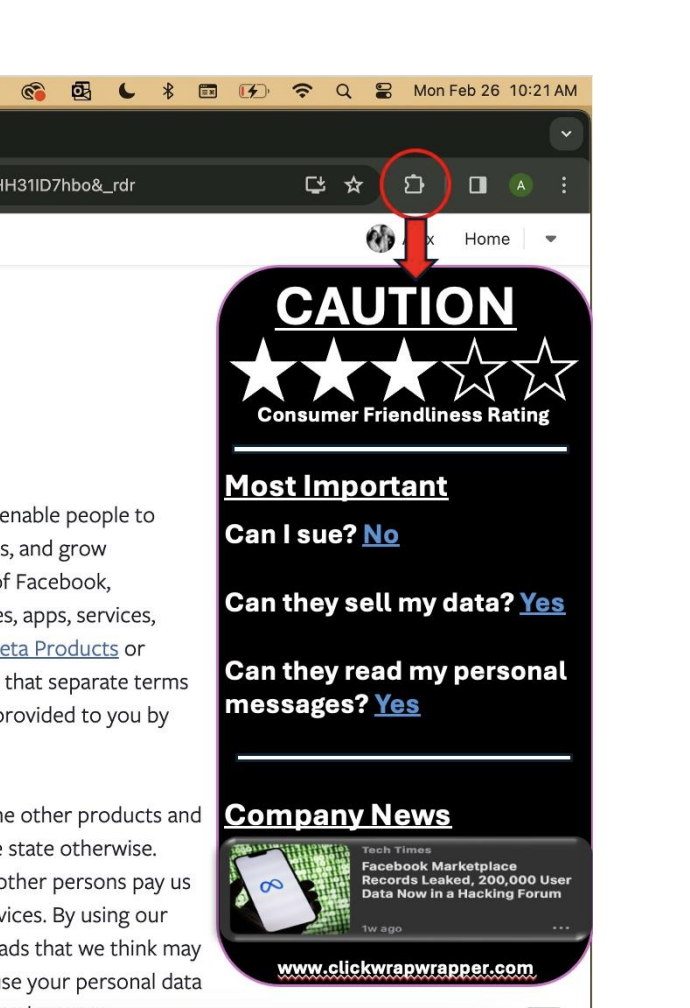The Challenge
The heart of this year’s problem rests on online “click to assent” agreements, a ubiquitous and pivotal feature of our increasingly digital world. We’re certain that every student has had experience with these agreements! Often presented to users in the form of a box to be checked or a button to be clicked, the agreements dictate the terms and conditions of using a website, software, or online service.
These online clickwrap agreements create some important tensions that the Future of Contracts Design Derby aims to address:
- For businesses – Easy processes like “click to assent” are critical for businesses, many of which contract with thousands (tens of thousands, or even millions!) of customers and users. To require more than this might saddle businesses with significant burdens, expenses, and challenges.
- For consumers – Yet, these easy structures might not achieve the understanding and consent that user—and especially individual consumers—want and need. After all, the great majority of everyday consumers click “I agree” without reading or fully comprehending these complex legal documents, raising significant ethical and legal questions.

Video from Prof. Jeff Ward with closed captioning about the Future of Contracts Design Derby and challenge in 2024.
The Details
Timeline
The 2024 Future of Contracts Design Derby begins with Step 1, background information about the challenge.
Then, the Step 2 Design Workshop took place at six designated sites and dates during the weeks of February 12 – March 8, 2024, with all final submissions of Step 3 due on March 8. Participants were provided a template for Step 3.
| Site | Hosted By | Universities in Attendance |
| Durham, North Carolina, USA | Prof. Jeff Ward | Duke University School of Law, North Carolina Central University School of Law, Campbell University School of Law |
| Norman, Oklahoma, USA | Prof. Kenton Brice | University of Oklahoma College of Law |
| Boston, Massachusetts, USA | Prof. Adam Eckart | Suffolk University Law School, Thomas R. Kline School of Law of Duquesne University |
| Atlanta, Georgia, USA | Profs. Patrick Parsons & Michelle Dewey | Georgia State University College of Law |
| Madison, Wisconsin, USA | Prof. Charlie von Simson | University of Wisconsin Law School |
| Pokfulam, Hong Kong SAR, China | Prof. Brian W. Tang | The University of Hong Kong (LITE Lab) |
After all submissions were received, 15 individuals reviewed the submissions and provided feedback. These individuals came from an array of backgrounds in legal, from small and large law firms to in-house counsel to academia and even legal aid.
Participants
We had 153 students across 40 teams from 9 universities! View photos
“The event was a great opportunity for us to be in a professionally creative space and work on a topic that is presently important for consumers. It showed that finding creative methods can be challenging but bouncing ideas off your counterparts can really bring an idea to life! We received highly validating feedback from the event mentors and are grateful for such an invigorating and enlightening experience.”
– Team 5
Themes

Students were asked to identify the specific problem related to clickwrap agreements that they were solving with their solution.
I agree” ≠ “I understand
Common themes emerging from their submissions regarding clickwrap agreements and terms of service include:
Lack of Comprehension and Understanding
Many users accept terms without fully comprehending them due to the length, complexity, and dense legal language used in clickwrap agreements and terms of service. This lack of understanding is compounded by the fact that consumers often do not read the terms thoroughly.
Imbalance of Power and Choice
Clickwrap agreements often present a “take-it-or-leave-it” scenario, leaving consumers feeling they have no real choice or bargaining power. Businesses design agreements primarily for their own legal protection, without considering consumer comprehension or preferences.
Complexity and Length
Online terms of service are typically lengthy, convoluted, and filled with legal jargon, making them difficult for the average consumer to navigate and understand.
Informed Consent and Notice
There’s a concern about whether consumers are truly providing informed consent when agreeing to terms of service modifications. Providing clear notice and ensuring meaningful engagement with changes is highlighted as crucial.
Efficiency vs. Clarity
There’s a tension between the efficiency needed for businesses and the clarity desired by users. Simplifying terms without compromising legal protection is a challenge.
User Engagement and Trust
Lack of consumer engagement in the terms of service process can lead to distrust and apathy. Building trust requires transparency, user-centric design, and opportunities for meaningful interaction with the terms.
Need for Reform and Alternatives
There’s a recognition of the need to rethink clickwrap agreements to provide consumers with more options and agency in accepting terms. Suggestions include simplifying terms, providing meaningful notifications, and incorporating strategies to improve user understanding and engagement.
Then students described their solution and its key components, showed reflection on what questions remained about their preliminary idea, and submitted artifacts showing their process and/or product.

“The Design Derby gave me and my wonderful teammates the rare opportunity in law school to tackle a large problem by simply exercising unbridled creativity. I truly believe that the entire legal community would benefit from similar environments that promote collaboration and exploration.”
– Alex Bartlow, CPA, Duke University School of Law ‘24
Thanks to all the teams for their thoughtful submissions! We are so proud of all of your work.
We heard themes among the solutions:
- Bespoke Basics: Terms Tailored to You
- Clarity, Not Clutter: Empowering User Comprehension
- No More Fine Print: Engaging Users in Plain Sight
- Your Terms, Your Way: Putting Choice in Users’ Hands
- Simplicity Meets Accessibility: Streamlining User Agreements
- Designed for Humans, Not Lawyers: Putting Users First
- Legally Legit, Risk-Free Reads: Protecting All Parties
- Click, Tap, Understand: Tech-Powered Terms
- Feedback-Driven Fine Print: Evolving with User Input
We also heard unique solutions:
- Use of songs to explain Terms of Service
- Changing the one “I agree” button at the end of a lengthy document to options like: Opt In and Opt Out, Maybe, and multiple “I agree” buttons throughout the Terms of Service
- Neutral third-party product
- A bipartisan government initiative to oversee standardized Terms of Service
- Pausing service until new terms are accepted
- Tracking the time a customer stays on the Terms of Service screen
Grand Prize Winners
Click on the image on the right to access the PDF slide deck.
Powerful Plug-In: ClickWrapGod, Duke Law
ClickWrapGod
ClickWrapGod is a generative-AI plugin targeted at consumers who are bombarded by constant clickwrap service agreements. Our plugin will be directly downloaded onto the user’s browser and “pop up” when it detects a clickwrap agreement being signed by the user.
- Alexandra Gomez
- Oscar Lama
- Kyle Larson
- Jake Stavsky

What the reviewers had to say: “I like the use of technology to solve the problem and the idea that the consumer can “train” the solution to point out the particular clauses that each consumer is interested in seeing. I also like the idea that the solution will point to other similar businesses with TOS more in line with those of the user. I also appreciate their considerations for how to make this commercially feasible. This actually sounds doable!”
Caution for Consumers: The Contract Lemurs, Duke Law
The Clickwrap “Wrapper”
A “warning label” for terms of service agreements, analogous to those found on cigarette packages, that provides a brief,
easily-understandable breakdown highlighting the most dangerous potential consequences of the contract for consumers.
- Drew Johnson
- Alex Bartlow
- Susan Murley
- Praise Nsoko-Nkwor

What the reviewers had to say: “Very creative and simple solution to highlighting the friendliness / unfriendliness of ToSs. Could see that companies would start competing for 5 stars, if this really took off.”
Modification Mavens: Team Beauty, NCCU Law
360 Engage
We not only want to engage our consumers with our website services and products, but we also want 360º engagement of our consumers which includes their legal input on the business process.
- Alfreda “AJ” Junious
- Kirsten King
- Alexis Hurd
- Tyra Hudson

What the reviewers had to say: “Nice use of a hypothetical company. A very clear problem statement about modifying terms of services.”
Active Acceptance: TOSifyME, Suffolk Law
Simplify Terms of Service for Me.
We strive to educate users about the clickwrap
agreements they’re accepting by slowing down
the “I Accept” process through a strategic and
interactive approach.
- Erin Wylie
- Matthew Waldron
- Caity Walsh
- Cesar Anaya-Delgado

What the reviewers had to say: “This team thought through their problem and solution in harmony. …. this is best suited for consumer settings.”
Honorable Mentions
Click on the image on the right to access the PDF slide deck.
Smart Summaries: Team Kennedii AI, Duke Law
AI-Generated Personality
Kennedii AI is a new generative AI tool that reads contracts and generates personalized summaries. Users can select the summary’s focus, level of complexity, language, format of presentation (video, pictograph, text), and the personality presenting.
- Cassie Shapiro
- Kennedii Brock
- Manuel Alvarez
- Zan Khan

What the reviewers had to say: “I would not be surprised to see future Chat Bot based solutions work along these lines.”
Accessibility All-Star: Team Onyx, Suffolk Law
Project C.L.E.A.R.
PROJECT C.L.E.A.R. is a protocol for creating:
Contract Language Everyone Accepts and Respects
- Gabriella Brown
- Antoinnette Golden
- Faye Golden

What the reviewers had to say: “I love how inclusive this idea is! Of the ones I reviewed, it did the best job of taking into account the various needs and challenges a consumer might have and designing a solution that addresses those challenges/needs- Digital Braille!!! Excellent!“
Privacy Pioneer: PriEdge AI Tech, The University of Hong Kong
PriEdgeAI
An on-edge AI tool designed to tailor the presentation of clickwrap agreements to individual user preferences, particularly around privacy concerns. This on-edge approach ensures that sensitive user data is processed locally on the user’s device, significantly reducing the risk of privacy breaches during data transmission or AI model training.
- Angus Fung
- Chen Zijun
- Jungmin Jang
- Zhou Chenyang
